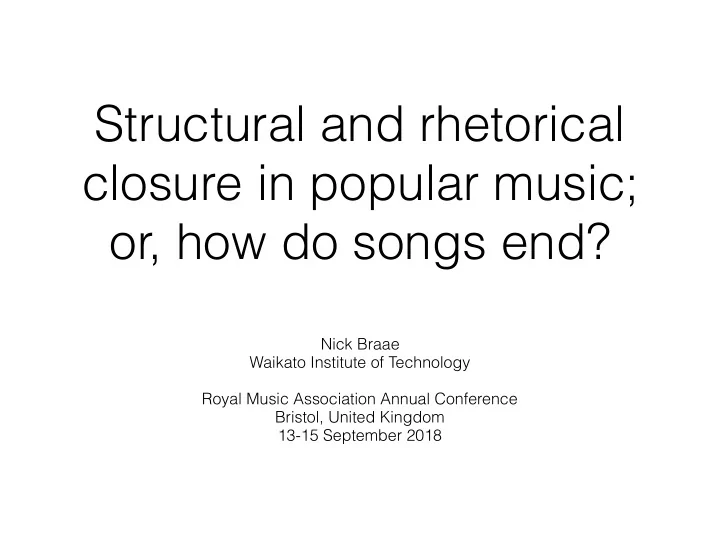

Structural and rhetorical closure in popular music; or, how do songs end? Nick Braae Waikato Institute of Technology Royal Music Association Annual Conference Bristol, United Kingdom 13-15 September 2018
Preliminaries • How do songs end? • Informed by broader concept of musical time in popular songs: the experiential pace, trajectory and flow of the music (de Sélincourt 1920; Langer 1953; Sauvage 1958; Pasler 1982; Kramer 1988; Danielsen 2006)
Endings in Popular Music • The ending shapes our understanding of what has happened and/or what we imagine might happen • Osborn (2013): terminally-climactic form—song ends with its structural highpoint; prevalent in post-1990s alternative rock • See also Malawey (2011): musical emergence; Spicer (2004): (ac)cumulative form; Samorotto (2012): “trope of infinity” • Models for understanding specific ending archetypes (cf. endings in general)
Closure in Popular Music (cont’d) • A model of closure: the features that evoke ‘finality’ and/or ‘stability’ (Agawu 1988) • Does closure exist? Vis-à-vis the fade out (Johnson 2002), temporal stasis (Danielsen 2006) • Or, is closure associated with recapitulation and reprise? ‘a bridge necessarily begins with some kind of harmonic swerve away from the preceding material and typically culminates in a big V chord…that sets up a dramatic, fresh reentrance of a verse or chorus, usually on the tonic’ (Spicer 2011: 13) • Closing gestures: the ‘Grand Plagal’ cadence in Led Zeppelin (‘Whole Lotta Love’), AC/DC (‘Back in Black’) (Temperley 2011) • Distinction between ‘structural’ closure (completion of formal ideas) and ‘rheotrical’ closure (use of closing gestures) (from Agawu 1988, Hyland 2009)
Table 1. Musical and lyrical devices that foster structural and rhetorical closure in popular songs Device that fosters structural closure Device that fosters rhetorical closure Local cadence to conclude song Return of initial thematic material at the end of the Jeff Lynne, ‘When I Was a Boy’ song, such as a verse or chorus Lack of final cadence (Queen, ‘My Fairy King’) Bruce Springsteen, ‘Born to Run’ Introduction of new material (Guns N’ Roses, ‘Sweet Child O’ Mine’) Harmonic stability of closing section Aretha Franklin, Song concludes with a ‘final’ chord ‘Think’ CCR, ‘Midnight Special’ Modulation in final section (The Beatles, ‘The End’) Fade out (Fleetwood Mac, ‘Rhiannon’) Completion of vocal/instrumental melody on the Textural diminuendo through final section tonic Queen, ‘Bohemian Rhapsody’ Elton John, ‘Your Song’ Constant texture through final section (David Bowie, Vocal melody ends off-tonic (Dire Straits, ‘On Every ‘Rock ’n’ Roll Suicide’) Street’) Resolution of any ambiguities and/or conflicts in the Textural expansion towards final climactic point song’s lyrical narrative Bread, ‘Diary’ The Darkness, ‘Love on the Rocks with No Ice’ Unresolved ambiguities and/or conflicts in the song’s Constant texture through final section (Eagles, ‘Hotel lyrical narrative (Dolly Parton, ‘Jolene’) California) Lyrical reference to ending Tracy Chapman, ‘Give Me One Reason’ Reference to continuing (Journey, ‘Don’t Stop Believing’)
Examples • The Darkness, ‘Love on the Rocks With No Ice’: structural reprise and emphasis of chorus; textural climax; grand plagal cadence; final chord; complete closure • Billy Joel, ‘Piano Man’: vignettes of hopeless characters at the local bar; is the titular character the saviour? • Finality of the ending; underscoring the definitive nature of the situation; there will be no change…
Disjunctures and Narrative Interpretation • Billy Joel, ‘Scenes From an Italian Restaurant’ • Meeting of two friends; dream-like transition into reminiscing about high-school sweethearts Brenda and Eddie • Return to original verse section (apparent structural closure; end of this story); subsequent modulation but rhetorical close (more stories to be told but another time…)
Disjunctures and Narrative Interpretation • Meat Loaf, ‘Paradise By The Dashboard Light’ • Tale of teenage love (lust?) • Builds to climactic point and narrative crux: ‘Stop right there!…Before we go any further, will you make me your wife?’ • The answer: ‘I couldn’t take it any longer, Lord I was crazed // I started swearing to myself and on my mother’s grave that I would love you till the end of time’ • But now he’s ‘praying for the end of time // So I can end my time with you’ • Complete structural closure of narrative, melodic-harmonic coincidence on tonic; but lack of rhetorical closure (chord pattern and background lyrics spinning out infinitely): narrator is definitively stuck in his endless misery
Disjunctures and Narrative Interpretation • Bruce Springsteen, Born to Run (1975) • Four ‘epics’—‘Thunder Road’, ‘Born to Run’, ‘Backstreets’, ‘Jungleland’—all celebrating the escapist possibilities from a life in a blue-collar town • Will the characters enact their dreams and break free? • ‘Thunder Road’: structural closure, but lack of rhetorical closure (infinite sense of dreaming); ‘Born to Run’ (rhetorical closure; relatively strong structural closure, but melody comes to rest on 5); ‘Backstreets’ (rhetorical closure; relatively strong structural closure, but melody comes to rest on 5); a sense of ambiguity about the celebratory tone of the songs… • ‘Jungleland’: strong rhetorical and structural closure; elaborate conclusion but never the definitive, complete sense of closure in the vocal melody (Springsteen avoids the tonic); leaves the slightest of empty feelings about the characters’ fate • ‘The River’: same characters five years on; no prospects of escape or a better life; complete lack of closure (structurally and rhetorically) suggesting their earlier dreams have been dashed for good
Conclusions • Structural and rhetorical closure as a model for understanding song endings from technical and interpretative perspectives • Relationship between approach to closure and style (e.g. Queen, 1970s rock/prog) • Understanding of modes of storytelling (vis-à-vis ‘narrative’ analyses of popular songs; also potential for comparison with film/TV approaches to narrative closure)
Recommend
More recommend